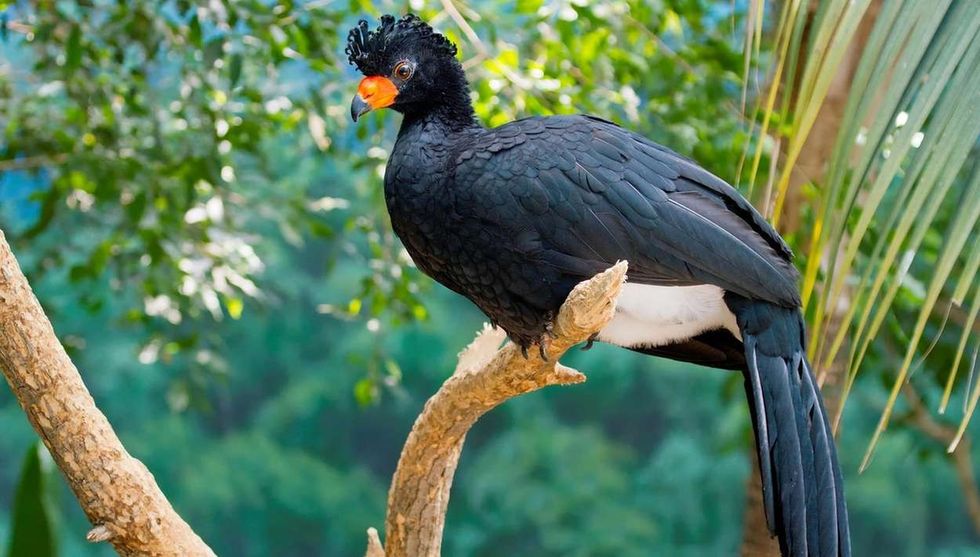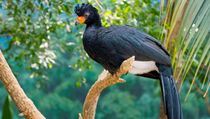Next time you go out for an expedition in the beautiful forests of South America, look out for these big birds. The wattled curassow is a species found only on this continent. This bird is almost the size of a turkey and is found in small groups.
A member of the Cracidae family, the population of wattled curassow (Crax globulosa) is concentrated in the countries of Ecuador, Brazil, Peru, Colombia, and Bolivia.
This bird has beautiful black plumage and the feathers on the crest are slightly curled. The most striking characteristic of this bird is the presence of the bright red cere and wattle on its black bill. Though this is not much too visible on female birds, males are known to be proud owners of this feature.
Their diet mainly involves crustaceans, plant matter, and invertebrates. Unfortunately, the estimated number of individuals in this species is very low with factors such as hunting and environmental destruction contributing to their population decline.
For more relatable content, check out these guan facts and chachalaca facts for kids.
Wattled Curassow Interesting Facts
What type of animal is a wattled curassow?
The wattled curassow is a type of curassow.
What class of animal does a wattled curassow belong to?
The Endangered wattled curassow (Crax globulosa) belongs to the class Aves.
How many wattled curassows are there in the world?
The population of these curassows has less than 5000 surviving individuals.
Where does a wattled curassow live?
These large curassows are found in South America, mainly around the region of the western Amazon basin. They are mainly based in the lowlands of Brazil, Colombia, Ecuador, Bolivia, and Peru.
What is a wattled curassow's habitat?
The wattled curassow habitat is mainly around seasonally flooded forests, rainforests, and gallery forests. They stay close to water sources like streams, lakes, and rivers.
Who do wattled curassows live with?
These curassows have been seen staying together in small flocks.
How long do wattled curassows live?
Though the exact lifespan of the wattled curassow (Crax globulosa) in the wild has not been estimated, a captive bird of this species can live up to 20 years.
How do they reproduce?
Mated wattled curassow pairs are very territorial. The new birds born disperse a little away from the parents’ grounds but stay around the same area.
The exact breeding season of these birds is unknown. However, reproductive activity has been noticed between the months of June to August. Male birds have special courtship rituals, strutting around their partners and inviting them with loud booming calls.
These birds follow monogamous relationships and are usually together for life. However, in rare cases where the male of one pair is unavailable such as hunted or killed, another pair would welcome the stranded female.
The nest built is usually made with leaves, twigs, and grass and incubation lasts for almost a month. The clutch size is usually two little eggs of white color, but this may vary up to six eggs as well. Both parents contribute equally in raising the young one.
What is their conservation status?
Unfortunately, the conservation status of the wattled curassow (Crax globulosa) is Endangered.
Wattled Curassow Fun Facts
What do wattled curassows look like?
This bird has a large body and the feather located on the head crest is slightly curled forwards. The males have an overall black plumage, however, the crissum is of white color.
The iris of this bird is of dark brown color and the legs and feet are also black tinted. The tip of the bill also ends in black. A round red knob is present around the base of the upper jaw which has a bony core.
The cere is present apically under the red knob and below the base of the mandible is a small wattle. The presence of this scarlet knob and the hanging wattle gives this bird its name.
The females also have black plumage. However, the crissal region is red-buff hued. Sometimes, the wing coverts have a slightly brown sheen. The female has a black bill and black iris, and her legs and feet are of a grayish hue.
The female does not have the large bill knob or the wattles. However, the cere is or a bright coral hue. The crest on the female’s head is shorter compared to the male’s.
Juvenile males have more of a yellow hue on their facial features.

How cute are they?
We would not really classify this bird as a cute one.
How do they communicate?
The crest present on the head is used to convey information or emotions. It is used to express aggression, inquisitiveness, and even nervousness. Male curassows make a booming call which is very low-pitched. They also make high shrill whistles.
How big is a wattled curassow?
These big birds are about 32-35 in (81-89 cm) long. This makes them almost seven times the size of the chipping sparrow.
How fast can wattled curassows fly?
Sorry, we do not have data on how fast this bird can fly.
How much do wattled curassows weigh?
These big birds weigh almost 5.5 lb (2.5 kg).
What are the male and female names of the species?
Males and females of this species do not have specific names.
What would you call a baby wattled curassow?
Baby curassows do not have any name. In general, a baby bird is called chick or nestling.
What do they eat?
This big bird is a prime omnivore and most of its diet includes leaves, fruits, seeds, and other plant matter. This diet is supplemented with other tiny animals such as fish, crustaceans like shrimp, insects, and other small animals.
Are they dangerous?
Wattled curassows are very territorial and would attack anyone who enters their range.
Would they make a good pet?
These curassows are well adapted to the wild and would not settle well if taken as a pet. They are also very aggressive.
Did you know...
Blue-billed curassows are sometimes hybridized with wattled curassows when kept in captivity.
The term 'globulosa' in its scientific name comes from the Latin word 'globus', meaning a 'glob'. This refers to the rounded cere and wattle.
Other birds native to Colombia and Brazil are the Andean condor, summer tanager, and Jandaya parakeet.
What are the different types of curassows?
There are four different genera coming under curassows. Three of these genera are native to South America entirely, while the genus Crax has its distributions towards the north of Mexico.
The genus Nothocrax has only one species under it, the nocturnal curassow. The genus Mitu has four species under it which are the crestless curassow, the razor-billed curassow, the Salvin’s curassow, and Alagoas curassow.
The helmeted curassow, the horned curassow, and the Sira curassow are three species in the genus Pauxi. The genus Crax has eight species under it which include the great curassow, Belem curassow, black curassow, blue-billed curassow, bare-faced curassow, yellow-knobbed curassow, and wattled curassow.
Why is the wattled curassow endangered?
Finding this bird in the wild is an almost impossible task. Reasons such as habitat destruction and hunting have led to the decline of their population.
It is said that the species disappeared from the lands of Ecuador back in the '80s, however, they have now found their way back to these regions. The only places where these curassows can be reasonably encountered are near the Juruá River in Brazil and near San Marcos in Bolivia.
Some specimens of their population have been kept in captivity for their safety, however, this bird rarely breeds in captivity and does not make up for the rapid decline in the total population.
Here at Kidadl, we have carefully created lots of interesting family-friendly animal facts for everyone to discover! Learn more about some other birds from our swan goose facts and trumpeter swan facts pages.
You can even occupy yourself at home by coloring in one of our free printable wattled curassow coloring pages.









